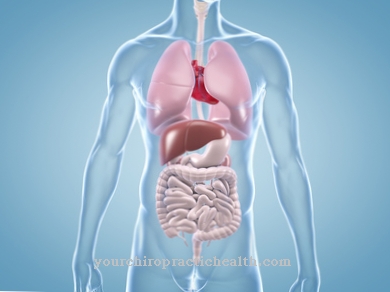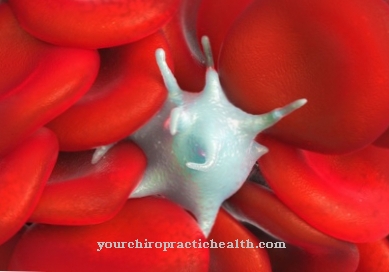The Neurulation is the formation of the neural tube from ectodermal cells in the context of embryonic development. The individual structures of the central nervous system later develop from the neural tube. In neurulation disorders, the formation of the neural tube is defective, which can result in various malformations of the nervous system.
What is the neurulation?

At the beginning of embryonic development, the human embryo differentiates into different cell layers. These cell layers are called the cotyledons and arise during gastrulation. Humans are triploblastic and thus have three cotyledons: the inner endoderm, the central mesoderm and the outer ectoderm. The cotyledons are programmed to develop certain tissues.
The development of the central nervous system begins in vertebrates with the formation of the so-called neural tube. This is an embryonic tissue structure that forms from the approach and fusion of the neural folds from the 19th day of embryonic development. This process is known as neurulation and corresponds to the folding of the neural ectoderm from the primary structure of the external ectoderm. Neurulation takes place under the influence of signal substances. These messenger substances come from cells of the axial mesoderm.
Function & task
The primary neurulation runs in phases. At the beginning, the neural plate is delimited on the surface of the ectoderm. The rostral ectoderm area in front of the primordial mouth and the primitive stripe thickens to a sole shape during these processes. In the next phase, the edges of the neural plates bulge into neural bulges and create a depression in the middle, which is known as the neural groove. The cells of the middle line attach to the notochord and form the deepest point of the neural groove.
During the subsequent phase, the neural bulges form neural folds. These folds meet in the middle and close the neural groove through their fusion. This is how the neural tube becomes the former neural channel. The neural fold fusion takes place on the basis of (N-) cadherin molecules of the cell membranes.
In the next phase of neurulation, the neuroectoderm separates from the outer germ layer. The remaining ectoderm grows together to form the surface ectoderm and migrates into the interior of the embryo. The cells of the former edge of the neural plate form so-called neural ridges on both sides of the neural tube.
The neural tube is the origin of the central nervous system. It folds around the 25th day of development. The anterior opening of the structure closes before the posterior opening closes, allowing the brain to develop in the anterior section of the neural tube. The sections further back form the spinal cord.
The neurulation is induced by messenger substances that come from the notochord. Protein factors such as noggin and follistatin inhibit further development of the surface epithelium and allow access to developmental genes for the nervous tissue. Together with growth factors, they are involved in the regional differentiation of the structures. In the middle neural plate, the cells of the ectoderm are selectively anchored to the notochord. They are first in the medial line, later merge into two dorsolateral formations and thus form the pivotal points for the shaping process. Cell shape changes can be achieved through precisely coordinated rearrangements of cytoskeletal parts. In coordination with the growth processes of the cell network, the bulging or retraction of certain structures is achieved. The fixed pivot points, in the form of an abutment, enable coordinated growth and thus precise shaping of the neural tube.
During the secondary neurulation Liquid-filled cavities form in the cell cord, which unite to form a tubular structure. The structure is connected to the lumen of the structure and filled by the neuroepithelium. In the second embryonic month, a caudal section is connected to the neural tube, which consists of mesodermal cells and develops into the tail section of the spinal cord. This secondary neurulation is initiated in humans, but does not continue to form an indicated tail structure.
Illnesses & ailments
Incomplete or defective neurulation results in malformations of the central nervous system. Neurulation disorders are also called dysraphias and a distinction is made between various sub-forms depending on the time at which they occur. A large group of dysraphs with different manifestations are detachment disorders of the neural tube. If a neurulation disorder sets in in the third and fourth week of gestation (pregnancy), dysraphic malformations of the nervous system develop. Such malformations are due to disturbances in the closure of the neural tube and can manifest themselves, for example, in the formation of a crack in the skull with meningeal and cerebral defects.
Craniorachischisis totalis is probably the most pronounced form of neurulation disorder and exposes the brain and spinal cord to amniotic fluid. Instead of neuronal tissue, there are connective tissue formations. Anencephaly is a somewhat milder malformation. In this disorder, the skullcap is missing, but the brain stem and cerebellum are usually present. However, children of this lighter form rarely survive the first few months.
Midline defects are also neurulation disorders and are associated with brain malformations or secondary brain damage. An example of diseases of this type is the Meckel-Gruber syndrome. Neurulation disorders are one of the most common areas in the spinal cord. Spina bifida occulta is the best example of such a manifestation, which is often symptom-free. The spina bifida cystica also affects the spine and is associated with paralysis and sensitivity disorders. In this context, an open form is distinguished from a skinned form. Other malformations based on neurulation disorders are syringomyelia and diplomyelia.
























.jpg)



